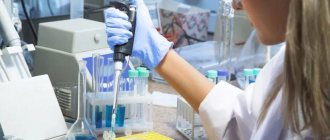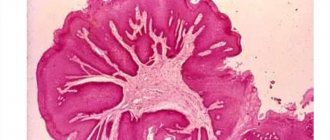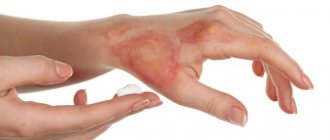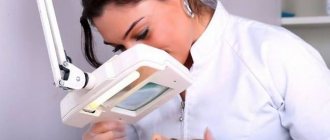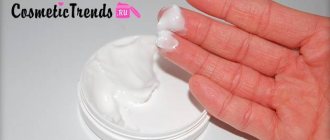Clear skin / Demodex / How to test for Demodex?
Demodex is a microscopic mite that is found in human skin.
It lives on the glands of the eyelashes, eyelids, facial skin, hair follicles, nasolabial folds, and chin. It is transmitted by airborne droplets . Causes the disease demodicosis, which is classified as a common chronic dermatoses.
At the first sign, it is necessary to do a demodex test . If it is not treated, it will begin to multiply, contributing to the appearance of acne, conjunctivitis and other diseases.
Symptoms of the disease
Demodicosis manifests itself depending on the location of the scabies mite.
Symptoms specific to the eyes:
- Rapid eye fatigue.
- Angioedema is manifested by swelling around the eyes, similar to an allergic reaction.
- Hyperemia of the skin in the area of the eyelid margin.
- Severe peeling of the skin around the eyes, especially in the area where the eyelashes grow.
- Severe loss of eyelashes, which mostly fall out without roots. If the eyelashes fall along with the roots, this may indicate alopecia areata or telogen effluvium.
Manifestations characterizing demodicosis of the skin:
- Red spots, mainly in the face area.
- Increased secretion of sebaceous fat.
- Presence of follicles and pimples on the skin.
- Paleness of the skin.
- The appearance of areas of peeling on the face.
- Itchy skin.
- If demodicosis is prolonged and no therapeutic measures have been taken, then hair loss on the head begins.
How to get tested for demodicosis
This disease is caused by subcutaneous mites that live in the sebaceous glands and hair follicles. They can remain in the human body for a long time without manifesting themselves. But if the work of the sebaceous glands is activated and against the background of a decrease in the immune system, symptoms of demodex occur, which are characterized by increased itching in the head, face and the appearance of rashes.
To make sure that the disease was caused by a tick from the genus Demodex, you need to get tested. This is human biological material that is tested in laboratory conditions. But the study should be carried out only when symptoms of demodicosis are present.
It is known that with this pathology the internal organs are not affected, the mite attacks only the upper layers of the epidermis, therefore scraping for demodex is carried out from the affected areas of the body.
An adult tick is oblong in shape and can only be seen under a microscope.
In small quantities these microorganisms are safe. Moreover, they regulate the acid-base and hormonal balance of epidermal cells. But if for some reason mites grow, they begin to multiply in the subcutaneous layer, causing symptoms of demodicosis disease.
Progress
Diagnosis of the disease is aimed at examining scrapings, studying eyelashes and hair follicles. The procedure itself does not cause pain to the patient. The patient can receive a transcript of the result after 72 hours. There are several ways to get tested and scraped to detect demodicosis. Let's look at each in more detail.
Eyelash analysis
Eyelash analysis is an informative method for identifying the causative agent of demodicosis. To do this, doctors pull out several eyelashes from the lower and upper eyelids. The material is placed under glass using special reagents. Then the laboratory assistant conducts a study: examines the material under a microscope and gives a conclusion.
Skin scraping
A scraping is taken for inflammatory phenomena on the skin. Biomaterial is collected from the damaged surface of the face. If there are no obvious signs of skin damage, then the material is collected from several places: the head, ears, face, thighs, and so on. Using a scalpel, the doctor separates a small area of the epidermis and collects the purulent contents of the inflamed follicle. Adds a 10% alkali solution to the collected material. After adding the solution, the doctor evaluates the area of the epidermis under a microscope.
If the result is positive, the doctor prescribes a therapy regimen, this allows you to get rid of demodicosis in the shortest possible time. During the examination, the doctor can identify two parasites:
- Short demodex.
- Long demodex.
It is several times more difficult to deal with a short parasite, since it can penetrate into the deep layers of the skin, where it multiplies.
A negative result is given not only in the absence of ticks, but also in the absence of traces of their presence in the body. A positive result is obtained if the laboratory technician notices a mite, shell or egg.
What is it and why is it needed?
Scraping for demodex is a procedure for selecting biological material for the purpose of studying its microflora. When the mite multiplies in the subcutaneous layers, it leads to itchy skin.
Analysis is necessary in order to distinguish demodicosis from other similar pathologies.
When the result of skin scraping for demodex is ready, the doctor will be able to confirm or deny the presence of the disease, after which treatment will be prescribed, which involves the use of drugs that affect the nervous system of the scabies mite and prevent its further division.
How is the test for subcutaneous mites carried out?
Demodecosis has different localizations:
- Subcutaneous epithelial layer of the body, head and face.
- Tissues and circumference of the eyelids.
Therefore, the order in which the biological fragment is scraped will also depend on which segment of the skin material is susceptible to infection.
If there is a suspicion of demodicosis of the epithelial tissues of the eyelids, then a dermatologist takes an eyelash from the eyelid for analysis, which in this disease is easily separated from it. Then the eyelash is placed in a special solution, which serves as a kind of preservative. If demodex is present in the tissues of the eyelids, then parasites and their eggs will be found on the eyelash follicle.
A scraping from the face on demodex or from other skin surfaces of the body is taken as a smear. A specialist laboratory technician uses a cotton swab to remove biological material from the surface most susceptible to disease. Then this cotton swab is placed in a sterile plastic package, where information about the patient undergoing examination is also indicated.
If the diagnosis is confirmed, it means that a family of demodex mites and their eggs were found in the smear.
Treatment
Demodectic mange of the eyelids is treated by an ophthalmologist if the eyes are the only focus of the disease.
To treat demodicosis of the scalp, you should contact a trichologist .
A dermatologist will help you get rid of facial demodicosis . The disease can be treated only after confirmation of the diagnosis.
The main goal of treatment is to destroy demodex , create unfavorable conditions for it, increase immunity, eliminate hormonal disorders, gastrointestinal diseases and other factors that affect its development and reproduction.
Treatment of cutaneous demodicosis
The patient is prescribed products containing metronidazole, zinc, ichthyol and many other components. The duration of therapy is up to two months.
To avoid relapse, it is not recommended to stop using medications early.
Vitamins and antihistamines are prescribed internally . Less commonly, metronidazole. The patient is prescribed a diet.
It is necessary to exclude from the diet:
- alcohol;
- spicy food;
- sweets.
During the period of therapy you should avoid wearing cosmetics. Bed linen and towels must be changed daily. It is better to wipe your face with disposable towels.
Cosmetic procedures are also very effective against demodex. During mesotherapy, special drugs are injected under the skin to eliminate it. Cryomassage can also quickly get rid of ticks.
Treatment of demodicosis of the eyelids
Therapy is long-term , and premature cessation of treatment may contribute to relapse. It is necessary to disinfect bed linen and personal hygiene items.
Clean the skin of the eyelids and eyelashes with calendula tincture using a cotton swab. After cleansing the skin and drying it, apply a medicinal cream prescribed by a doctor (Demalan, Demazol and others). All inflamed areas of the skin are treated.
If there are symptoms of purulent damage to the mucous membrane of the eye, additional antibacterial eye drops (Tobrex, Tsipromed and others) are instilled.
In order to increase the effectiveness, drug therapy is supplemented with eyelid massage, ozone therapy, and the doctor can also prescribe medications to correct the functioning of the immune system and normalize metabolic processes.
A long-term absence of necessary therapy can lead to various infections and complications: acne, rosacea, seborrheic dermatitis and other diseases.
Therapy will be effective only with correct diagnosis . At the first symptoms, you should consult a doctor and do the necessary tests.
chistaya-koja.net
Scraping in vitro
Where will a demodex scraping be most informative - in the laboratory or in other medical institutions?
The most informative analysis will be a scraping in a laboratory. In this case, it will be possible to identify the type of tick that attacked the skin and select the necessary treatment.
Depending on its type, the location of its distribution will be determined:
- Demodex brevis - this type of scabies mite lives in the sebaceous glands, so scrapings are taken from the affected surface.
- Demodex folliculorum is common in hair follicles, so taking 2-3 eyelashes will be enough for analysis.
If you are interested in where to submit a scraping for demodex, it is better to ask your doctor about this. He can refer the patient to a laboratory at a public clinic or to private medical centers. For example, in Moscow you can contact “ON CLINIC”, “Elegy”, “MedicCity”.
Indications
Scraping for demodex is prescribed when there are characteristic signs of infection with the parasite, but sometimes the disease is asymptomatic.
Factors that provoke active reproduction of mites and progression of dermatosis:
- reduced immunity (due to diabetes, HIV, lupus erythematosus);
- hormonal pathologies;
- gastrointestinal diseases;
- abuse of coffee, alcohol, solarium, bath;
- stress.
Demodex infection is manifested by the following symptoms (they are also indications for analysis):
- redness, bumpiness, peeling of facial skin;
- rosacea, papules, purulent pimples, ulcerations, enlarged pores;
- itching in the ears, on the eyelids;
- gray tint of facial skin (observed in certain areas);
- partial baldness;
- discomfort when blinking, blepharitis (acute or chronic inflammation of the eyelids);
- loss of eyebrows, eyelashes covered with light scales;
- slight increase in the size of the nose (rhinophyma);
- pain during facial movements;
- itching of the facial skin when using cosmetics, as well as in the cold.
In the afternoon, it is time for Demodex to mate. At night, the parasite can leave the feeding site and migrate along the surface of the skin. In this case, the infected person is bothered by the sensation of crawling on the face.
The discomfort continues throughout the night, causing the person to suffer from insomnia. At the final stage of the disease, the skin thickens and turns into a conglomerate of bluish bumps and acne.
These signs do not always indicate infection with Demodex, but you can verify the absence of a mite only through analysis (scraping).
You should not try to relieve symptoms with cosmetics or antiseptics. This can provoke increased reproduction of the parasite, since Demodex readily feeds on some of them.
Women, in search of the causes of rashes, first of all turn to cosmetologists or gynecologists (to rule out the hormonal nature of the pathology), which is a mistake.
Without analysis and appropriate treatment, the situation will not change. Demodicosis itself is extremely rare, only in the initial stages, with no signs yet visible.
Eyelashes for demodex analysis
If it is indicated to take eyelashes for analysis, then you should not be afraid of the pain; the procedure for pulling them out is absolutely painless. Moreover, only 2-3 eyelashes are needed for the study. If demodicosis is present, the affected eyelash bulbs quickly separate from the skin.
In order for the analysis to give a reliable result, it is necessary to follow some rules:
- Do not wet your eyelashes the day before the test.
- Do not apply decorative cosmetics or medications to the eye area.
- When washing your hair, do not allow shampoo to come into contact with your eyes two days before going to the laboratory.
- Stop taking eye drops the day before going to the test. Exceptions are those cases when drug withdrawal may cause negative consequences.
If the symptoms of the disease are pronounced, but demodex was not detected in the tests, then it is worth thinking about the fact that the patient has signs of seborrhea.
Self-analysis
It happens that it is not possible to conduct an analysis for demodicosis in the laboratory. You can also make it at home. To do this, you need to collect several eyelashes during the day, and if scabies has developed on the skin, then stick adhesive tape to the rash, preferably overnight. The next morning she is squeezed between two glasses.
After this, any family member can go to the laboratory with the submitted biological material. After which a microscopic examination is carried out.
Despite these actions, this method of identifying the disease is not so informative. And sometimes the analysis is repeated in a laboratory setting.
Rules for scraping for demodex
As it was found out, scraping the demodex mite itself does not bring any inconvenience, pain or discomfort to a person. But in order for his data to be the most informative, the following rules should be followed:
- 1-2 days before going for the test, you do not need to apply decorative, medicinal or other skin care cosmetics to your skin.
- One day before the scraping is taken, you are not allowed to wash your face.
- It is advisable to take scrapings after 6 pm, since during the daytime, when exposed to sunlight, the tick can hide and the analysis data will be incorrect.
- The material is taken from the affected areas, if the disease has not yet manifested itself, then from several random areas of the skin where microorganisms can presumably live. Most often these are the following places: scalp, face, eyelid area, ears, thigh, back, chest.
If the analysis did not reveal mite larvae and the scabies itself, this means that the disease is absent. If demodex is detected in the scraping, a repeat examination will be required.
The patient learns about this on the third day after a laboratory study of the biological material.
Timely diagnosis of the disease allows you to identify the disease in the early stages and easily cope with it. It is not difficult to identify demodicosis; it is enough to take a scraping for demodex and wait for the result, and a dermatologist will select the therapy.
Preparation
To get accurate test results, you need to prepare. Before scraping or taking eyelashes for examination, the patient must adhere to several rules:
- Do not wash your face for 24 hours.
- Do not use cosmetics, creams and ointments.
- When washing your scalp, avoid getting soap in your eyes.
- Stop using eye drops. If the patient has a serious eye disease, then you must notify the doctor when taking tests.
The tick that causes demodicosis cannot tolerate daylight, so its main activity occurs at night. In the morning it goes to the deep layers of the skin and only bothers the patient in the evening. Hospitals offer tests in the morning, so the tick may not be detected. As a consequence: a treatment regimen is not prescribed. To get a reliable result, doctors recommend taking the test after 6 pm.





